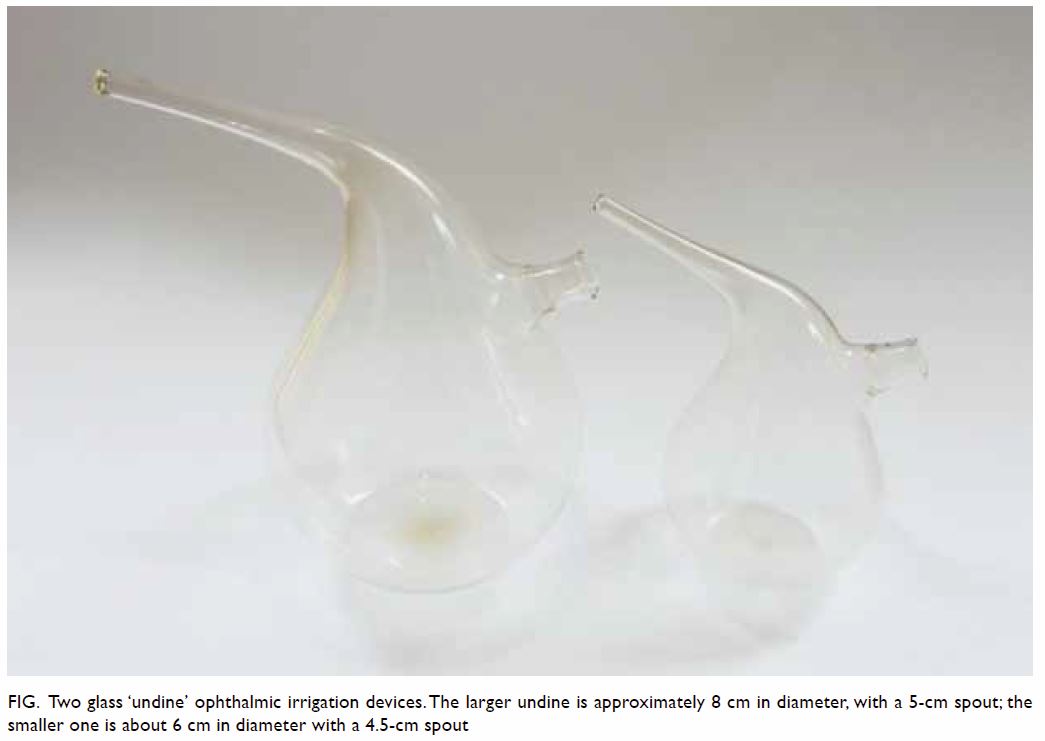© Hong Kong Academy of Medicine. CC BY-NC-ND 4.0
REMINISCENCE: ARTEFACTS FROM THE HONG KONG MUSEUM OF
MEDICAL SCIENCES
Glass undines for eye irrigation
Harry YJ Wu, MD, DPhil
Medical Ethics and Humanities Unit, Li Ka Shing
Faculty of Medicine, The University of Hong Kong, Pokfulam, Hong Kong
These two undine ophthalmic irrigation devices (Fig) were donated to the Museum in 2005 by Dr FK
Wong. Made by British surgical instrument specialist, Dixey Instruments,
Ltd, the date of production is unknown. They were mostly used between the
1930s and the 1960s before single-use plastic disposable equivalents were
available.1 Although they have retired from use, they bore witness to a
fascinating period of eye care and eye diseases in Hong Kong.

Figure. Two glass ‘undine’ ophthalmic irrigation devices. The larger undine is approximately 8 cm in diameter, with a 5-cm spout; the smaller one is about 6 cm in diameter with a 4.5-cm spout
The term “undine” was commonly used to refer to
these types of eye irrigation devices. One can easily understand by
looking at the water droplet shape of the device that the name “undine”
was inspired by the imaginary water elemental of ancient Greece. Undines
appeared in the well-celebrated Swiss physician Paracelsus’ (1493-1541)
writings on alchemy. In classical literature, undines were mostly found in
pools and around waterfalls in the forest. In ophthalmology, undines were
used to pour cleaning liquid on the conjunctiva. These pear-shaped glass
flasks are quite small: the large one measures about 8 cm in diameter,
with a spout which is about 5 cm long; the small one is about 6 cm in
diameter and spout about 4.5 cm long. There is one opening at the top of
the spout and another collared opening for filling on the lateral side.
While using the undine, the practitioner had to control the flow of liquid
with a finger over the filling hole while carefully trickling liquid onto
the patient’s eye.
In 1953, as reported by the first consultant
ophthalmologist in Hong Kong, British army colonel Dr GC Dansey-Browning,
the most common eye disease was acute infection of the anterior segment of
the globe (ophthalmia) related to malnutrition. Other diseases such as
phlyctenular disease, syphilis, and trachoma were worsened by the living
conditions of the poor people. For example, overcrowding in urban areas
accelerated the spread of ophthalmia. Furthermore, compared with a Western
diet including dairy, Cantonese foods such as congee contributed to the
subnutritious conditions. An inadequate water supply was also a major
factor that worsened the condition of trachoma in Hong Kong. In addition,
infestations of parasites such as Clonorchis sinensis were common
and could lead to phlyctenulosis. Syphilis was not an uncommon cause of
blindness at that time.2 Unfortunately, many doctors who treated these
diseases were not qualified ophthalmological specialists but Eye-ENT
practitioners. In 1957, The Medical Registration Ordinance regulated that
“no person, unless he is a registered medical practitioner or is
provisionally registered, shall hold himself out as being qualified,
competent, or willing to undertake the treatment of diseases of the human
eye or the prescription of remedies therefore.”3 Since then, ophthalmic
services became standardised and began to proliferate.
Eye irrigation is a common procedure in the
ophthalmic practice. It is useful for removing foreign material, debris,
chemicals, or mucus from the surface of the eye or eye socket. In cases of
emergency, irrigation is also important to minimise damage and potential
loss of eyesight. To facilitate the rendering of appropriate first-aid
treatment, or just to make irrigation quickly and conveniently performed,
the design behind medical devices becomes crucial. Over time, novel
designs of portable eye irrigation units became available, partially owing
to the demand from industrial sites. For example, in Britain, irrigation
was needed when irritant fumes injured the eyes of the personnel of mine
rescue teams.4 Despite striving for convenience, these devices used to
consist of multiple parts that required tedious disassembling and
reassembling.
Besides portability, material was also important.
Undines made of glass are formed with integrated container and spout. In
the late nineteenth century, glass became extensively used in science, but
it was almost exclusively used in the field of physics. The wider
application of glass, in chemistry for example, did not develop until the
emergence of glassblowing technology, which was useful in producing
ampules and vessels.5 In the 1930s, the malleability of glass availed
itself to become more extensively used for producing devices for storage,
vials, and tubing. The creation of glass undine irrigation devices also
kept up with the trend during this period.
As glass undines required laborious cleaning and
sterilisation processes, new materials were gradually demanded. Scientists
started to experiment with plastic materials in the late eighteenth
century. However, it was not until plastic production techniques became
more advanced and sophisticated in the mid-twentieth century that the new
material began to dominate the healthcare market. In fact, one of the main
reasons that ophthalmologists ceased using glass undines in the 1960s was
because they could cause physical injuries to the eyes if not handled
carefully. They were replaced first by devices with a cannula delivery
system, connecting small plastic or metal tips. In the present day,
plastic disposable undine equivalents are most popular because they are
cheaper and easier to handle. Nowadays, discussion has again emerged
regarding the environmental impacts of plastic and its potential
substitutes.
References
1. Undine eye irrigator. Museum of Health
Care at Kingston, Canada. 2017. Retrieved 12 Sep 2017.
2. Dansey-Browning GC. Ophthalmic disease
in Hong Kong. Br J Ophthalmol 1958;42:394-401. Crossref
3. The Medical Registration Ordinance. Part
V: Exemptions and Regulations. 32. Treatment of diseases of the eye. 1957.
4. Fernandez RH, Watkins JT. Portable eye
irrigation unit. Br J Ophthal 1957;41:626-8. Crossref
5. Jackson CM. The “wonderful properties of
glass”: Liebig’s Kaliapparat and the practice of chemistry in glass. Isis
2015;106:43-69. Crossref

